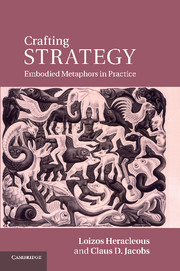Book contents
- Frontmatter
- Contents
- List of figures
- List of tables
- Preface
- Acknowledgments
- Vignette A BASF PerForm
- Vignette B UNICEF
- Vignette C Project Voltigo
- Vignette D Hephata Foundation
- Vignette E Privatbank IHAG Zürich AG
- 8 Strategy as a crafting practice
- Vignette F World Vision New Zealand
- Glossary
- Index
- References
8 - Strategy as a crafting practice
Published online by Cambridge University Press: 05 June 2011
- Frontmatter
- Contents
- List of figures
- List of tables
- Preface
- Acknowledgments
- Vignette A BASF PerForm
- Vignette B UNICEF
- Vignette C Project Voltigo
- Vignette D Hephata Foundation
- Vignette E Privatbank IHAG Zürich AG
- 8 Strategy as a crafting practice
- Vignette F World Vision New Zealand
- Glossary
- Index
- References
Summary
Strategy has traditionally been thought of as an ideally rational, structured and objective process, and in this has led to a mainstream that has neglected understanding of the interpretive and discursive aspects of strategic praxis (what practitioners do) and practices (regularities and aggregations of strategic praxes) (Whittington, 2006). In spite of recent constructionist and discursive developments in the understanding of strategy (Barry and Elmes, 1997; Buergi, Jacobs, and Roos, 2005; Jacobs and Heracleous, 2005, 2006; Vaara, Tienari, and Santti, 2003), the role of metaphor, and particularly what we refer to as “embodied metaphors,” remains largely unexplored by mainstream strategy theorizing. As previously discussed, the term “embodied metaphors” encompasses two interrelated ideas: first, the emergent and iterative construction of a simultaneously physical as well as metaphorical object directly involves the body in this process. Secondly, and importantly, however, the resulting physical metaphors have a body; they are metaphors in the flesh that can be touched, moved, and examined from various angles, and that can serve as engaging occasions for sensemaking.
In this chapter we present an approach to strategizing through a process of crafting embodied metaphors. In this context we view strategy as a practice of crafting, where actors both metaphorically as well as literally construct their perceptions of strategic issues through and into embodied metaphors within facilitated workshops.
Information
- Type
- Chapter
- Information
- Crafting StrategyEmbodied Metaphors in Practice, pp. 177 - 203Publisher: Cambridge University PressPrint publication year: 2011
